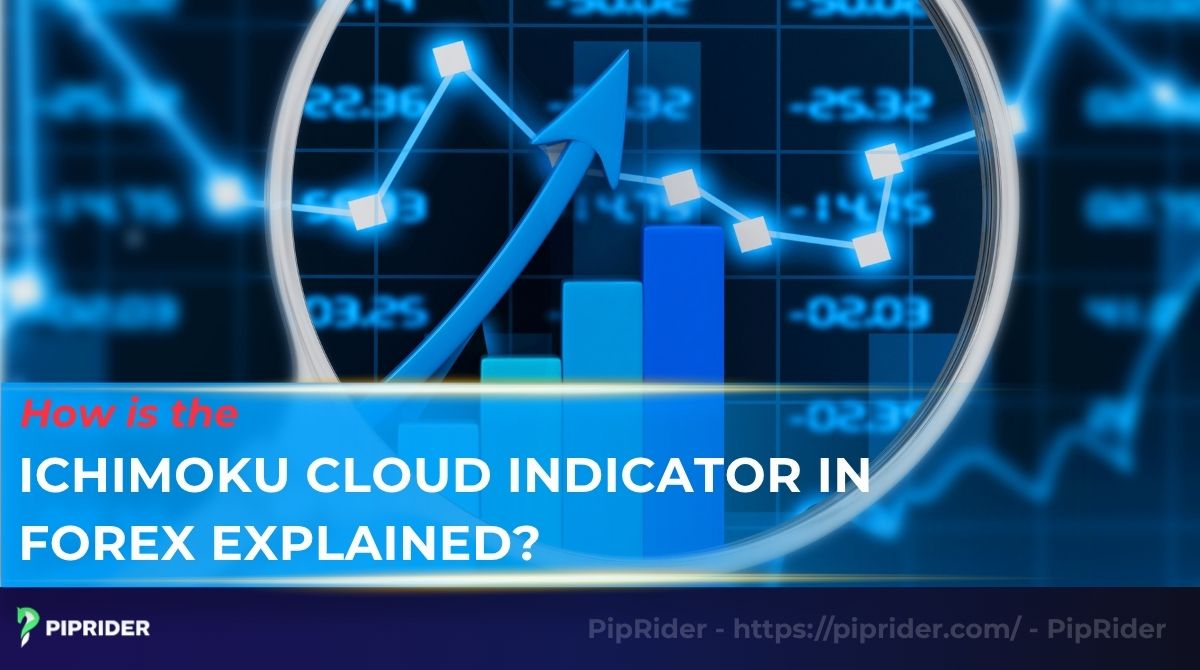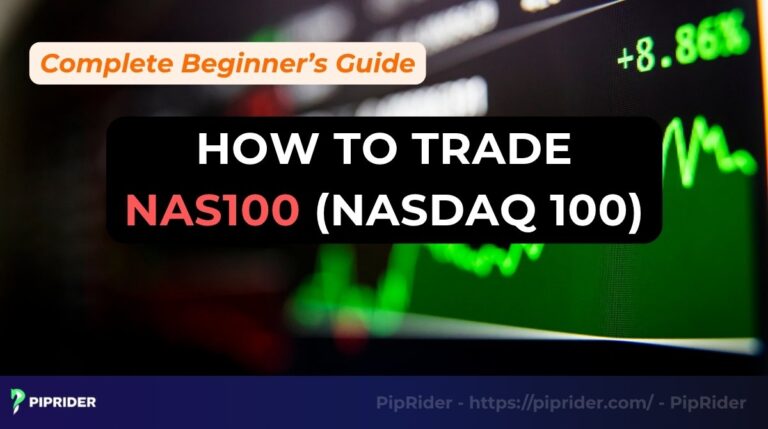If you’ve ever felt overwhelmed by cluttered charts with multiple, often conflicting, indicators, you are not alone. The Ichimoku Kinko Hyo, known as the Kumo Cloud or simply the Ichimoku Cloud was conceived to resolve this exact issue.
Ichimoku Cloud isn’t just another indicator; it’s a comprehensive, self-contained technical analysis framework that delivers a deep, multi-layered view of the market on a single chart. Despite its initial complexity, this guide aims to do precisely that: break down the Ichimoku Cloud Indicator in Forex Explained from top to bottom by decoding its five core elements and presenting clear, actionable strategies.
Key Takeaways
- Ichimoku functions as an integrated system: It simultaneously shows the trend’s path, its strength, and key dynamic support/resistance levels.
- The Ichimoku Cloud is the visual foundation: Price holding above the cloud signals a bullish environment, while action below it suggests a bearish one.
- The Tenkan/Kijun cross flags strength shifts: This serves as an initial alert for a potential trend reversal.
- The Chikou Span offers final confirmation: It validates signals by checking if the path is clear of historical price congestion.
- Confluence is paramount: The highest-probability setups occur when all five elements of the system align to tell a unified story.
1. What is the Ichimoku Cloud indicator?
The Ichimoku Cloud is an all-in-one technical analysis indicator that displays a comprehensive view of the market on a single chart. It clearly shows the prevailing trend, momentum, and key support and resistance zones, eliminating the need for multiple separate tools.
Japanese journalist Goichi Hosoda spent decades (1930s-1960s) refining this system before releasing it publicly (Investopedia, 2025).
Ichimoku was engineered to let a trader instantly evaluate three critical market aspects “at a single glance”:
- Trend direction: Is the market trending up, down, or is it directionless?
- Momentum: Is the current move powerful and sustained, or is it weakening and likely to fade?
- Support and resistance: Where are the key dynamic zones that price will likely respect?

The “at a glance” philosophy: Reading the market in 5 seconds
Ichimoku can help traders to make a quick market assessment by focusing on three key visual cues.
- Price vs. Kumo: Is the current price above, below, or inside the Cloud? This instantly tells traders if the trend is bullish, bearish, or in a state of consolidation.
- Future Kumo: The Cloud’s color and direction 26 periods ahead confirm trend strength. A blue cloud signals a future uptrend, while a red one indicates a downtrend. This change, known as a kumo twist, is determined by Senkou Span A’s position relative to Senkou Span B.
- Chikou Span: Is it above or below past price action in “open air”? This final check validates that the current price move is legitimate and not obstructed by historical resistance levels.
When these three elements align, traders can form a high-probability bias in just a few seconds.
2. How to Use the Ichimoku Cloud Indicator in Forex Trading
Though initially created for the Japanese equity market, the Ichimoku system has gained immense popularity and effectiveness in Forex trading. This success stems from its core principles being perfectly aligned with the currency market’s unique dynamics.

- A natural fit for a trending market
The Forex market is known for its ability to form powerful, extended trends. Ichimoku, being a trend-centric system at its core, is perfectly designed for this environment. Its components are specifically engineered to identify the birth of a new trend, validate its health, and signal when it might be nearing exhaustion.
- Handles the 24/7 market with ease
The currency market operates around the clock. A defining feature of Ichimoku is the Kumo Cloud, which projects potential support and resistance zones 26 periods into the future. This ensures traders always have relevant S/R levels mapped out on the chart, regardless of the trading session.
- Allows for rapid, multi-pair analysis
A typical Forex trader might monitor numerous currency pairs. Ichimoku facilitates a swift ” go/no-go ” assessment. Traders can glance at an Ichimoku chart and, within moments, ascertain if a clear, tradable setup exists or if it’s better to move on, saving a significant amount of time and mental energy.
Read more:
A-Z Guide To Using The Half Trend Indicator Effectively
The Parabolic SAR Indicator: A Beginner’s Trading Guide
Supertrend Indicator: Definition, Formula, Proven Strategies
3. How the Ichimoku Cloud works
The Ichimoku Cloud works by plotting five distinct lines that together provide a complete view of the market:
- Defining Trend and S/R: The Senkou Span A and Senkou Span B form the “Cloud” (Kumo). This Cloud is the system’s foundation.
- When the price is above the Cloud, the trend is bullish (the Cloud acts as support).
- When the price is below the Cloud, the trend is bearish (the Cloud acts as resistance).
- When price is inside the Cloud, the market is seen as consolidating or choppy.
- Signaling Momentum: The Tenkan-sen (Conversion Line) and Kijun-sen (Base Line) function like moving averages. A crossover between these two lines signals a potential shift in momentum.
- Confirming Signals: The Chikou Span (Lagging Span) provides confirmation by showing the current closing price shifted 26 periods into the past. If it’s above the past price, it confirms bullish strength.
The system is distinguished by the Cloud’s forward projection: it is displayed 26 periods ahead to outline potential future support and resistance zones.
4. Decoding the 5 components of Ichimoku
To master the system, traders must first understand the specific role of its five elements. Think of them as five members of a board; a trading decision is only validated when they reach a consensus.
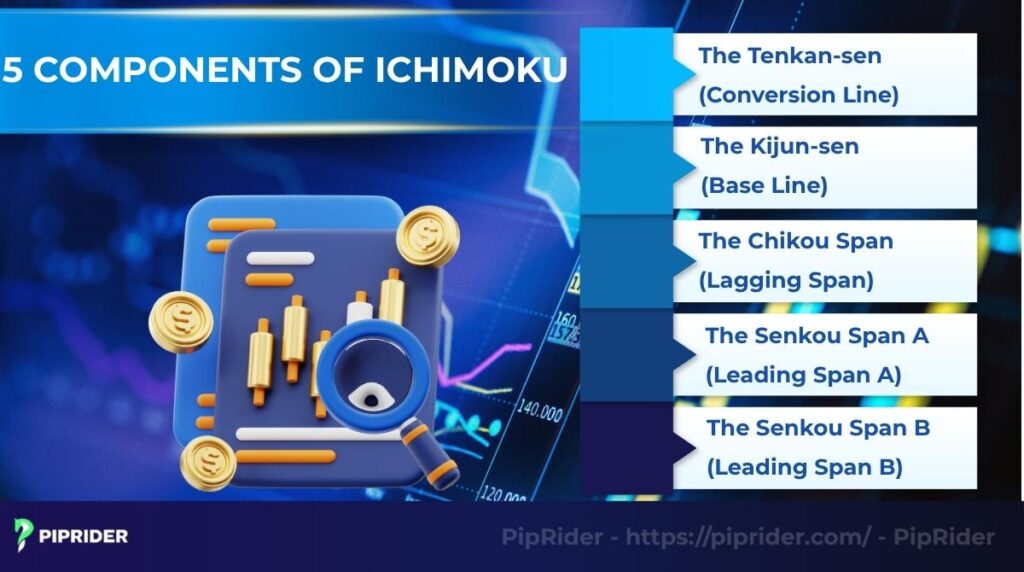
4.1. The Tenkan-sen (Conversion Line)
The Tenkan-sen is the system’s most responsive line, calculated from the midpoint of the last 9 periods’ high and low. Think of it as the system’s “initial trigger” or a gauge of short-term momentum. It is highly sensitive to immediate price shifts.
4.2. The Kijun-sen (Base Line)
Derived from the midpoint of the last 26 periods’ high and low, the Kijun-sen acts as the market’s medium-term equilibrium point. An upward-sloping suggests a healthy trend, whereas a horizontal Kijun indicates a market in balance.
4.3. The Chikou Span (Lagging Span)
This is one of Ichimoku’s most distinctive features. The Chikou Span is simply the current closing price time-shifted 26 periods into the past. Its function is to provide ultimate confirmation. By looking backward, it helps traders instantly see if the current price is free from historical price congestion.
4.4. The Senkou Span A (Leading Span A)
The Senkou Span A establishes the faster edge of the Ichimoku Cloud. Its value is derived from the average of the Tenkan-sen and Kijun-sen
| [(Tenkan + Kijun) / 2] |
with the result plotted 26 periods in advance. It represents the midpoint of the short and medium-term price equilibrium, projected forward (LightningChart, 2025).
4.5. The Senkou Span B (Leading Span B)
The Senkou Span B serves as the Ichimoku Cloud’s slower-moving and more structurally significant boundary. Its value comes from the midpoint of the last 52 periods’ high and low
| [(52-period High + 52-period Low) / 2] |
and this result is also displayed 26 periods ahead. It represents the long-term price equilibrium, giving the cloud its foundational strength.
5. Core Ichimoku trading strategies for Forex
Now, let’s assemble the components into actionable trading signals. The most reliable signals emerge when these events unfold in a logical sequence.
5.1. The Tenkan-sen and Kijun-sen cross
The Tenkan-sen and Kijun-sen cross is often the first indication of a potential momentum shift. It is analogous to moving average crossovers but is generally more responsive.
- Signal for bulls: This happens when the quicker Conversion Line moves across and above the slower Base Line.
- Signal for bears: This happens when the Conversion Line moves across and below the Base Line.
Important note: The signal’s validity is highly dependent on its location relative to the Ichimoku Cloud. An upward-trending cross occurring above the cloud is significantly more robust than one happening below it.
5.2. The Kumo breakout
The price exiting the cloud serves as the primary trend validation signal. It suggests that price has conclusively moved out of a combination phase and is embarking on a new trend.
- Bullish breakout signal: Price moves upward and secures a closing candle above the Ichimoku Cloud’s resistance.
- Bearish breakout signal: Price breaks out and closes below the Ichimoku Cloud.
This is one of the most dependable methods for entering a newly established, powerful trend.
5.3. The Chikou Span cross
The Lagging Span cross acts as the final confirmation filter. It verifies that there are no significant price hurdles in the recent past that could obstruct the new trend.
- Bullish confirmation: It moves above the price action from 26 periods ago and is in “open air” (not obstructed by past candles).
- Bearish confirmation signal: It is observed crossing below the price levels from 26 periods in the past.
6. A complete Ichimoku checklist for high-probability trades
The system’s real power comes from “confluence”, the alignment of all its elements. Here is a simple checklist for spotting a robust, high-probability setup.
6.1. Checklist for a strong buy signal
Price is positioned above the Kumo
- The forward-looking Kumo should favor the bulls, with Senkou Span A positioned higher than Senkou Span B.
- The Conversion Line has crossed above the Base Line.
- The Lagging Span is above the price from 26 periods ago and has clear space to move up.
- An upward trajectory on the Base Line provides additional validation for the trend’s positive strength.
6.2. Checklist for a strong sell signal
Price is positioned below the Kumo
- The forward-looking Kumo should favor the bears, with Senkou Span A positioned lower than Senkou Span B.
- The Conversion Line has crossed below the Base Line.
- The Lagging Span is positioned below the price from 26 periods ago.
- The Base Line is angled downwards.
6.3. Defining your exit strategy
Knowing how to exit a trade is just as critical as entering it. The Ichimoku system provides its own logical levels for managing risk and protecting profits.
- Using the Base Line: For a long position, traders can place a stop-loss just below it. This line represents the market’s medium-term equilibrium, and a close below it signals a potential shift in strength. For a short position, traders would place one just above.
- Using the Kumo: For a more conservative stop-loss, place it on the opposite side of the cloud. For a long position, this means placing the stop-loss below this zone. The Kumo is a strong support/resistance area, and a breakthrough indicates a significant change in the trend.
A price break below these levels is a strong signal that the initial trade setup may be invalidated.
7. Advanced Ichimoku combination strategies
While Ichimoku is a powerful methodology on its own, its signals can be further refined by pairing it with complementary indicators. This practice helps filter out market noise and validate trades with greater confidence.
7.1. Ichimoku and RSI for filtering entries
The Relative Strength Index (RSI) is an excellent tool for assessing short-term momentum exhaustion. It can be used to avoid buying at a local top.
- Strategy: In a confirmed upward-trending trend (price above Kumo), await a pullback that brings the RSI close to the 50 level. A subsequent bounce from this level provides an excellent, high-probability entry point to rejoin the main trend.
- Benefit: This approach prevents traders from chasing an overextended trend and allows for entry during a combination period, often resulting in a superior risk/reward ratio.
7.2. Ichimoku and MACD for momentum confirmation
The MACD is an outstanding tool for corroborating momentum. An Ichimoku signal carries much more weight if the MACD tells the same story.
- Strategy: Look for an upward-trending price exiting the cloud. This signal’s potency is greatly increased if it’s accompanied by an upward-trending MACD crossover (when the MACD line moves above the signal line) at roughly the same time.
- Benefit: Creates a “dual-engine” confirmation of strength, lending much higher confidence that a new trend possesses legitimate underlying power.
7.3. Ichimoku and volume for breakout validation
Analyzing trading volume helps confirm the conviction driving a price move. A breakout that lacks volume is often a trap.
- Strategy: When traders spot a price exiting the cloud, examine the volume bars. A breakout that is supported by a significant increase in volume is much more reliable than one occurring on low volume.
- Benefit: Volume analysis helps traders distinguish between a genuine, institutionally supported breakout and a “false-out” designed to trap unsuspecting retail traders.
8. Common mistakes with Ichimoku and how to avoid them
Like any complex tool, Ichimoku can be misapplied. Traders new to the system frequently fall into the same predictable pitfalls. Recognizing them is the first step toward avoiding them.
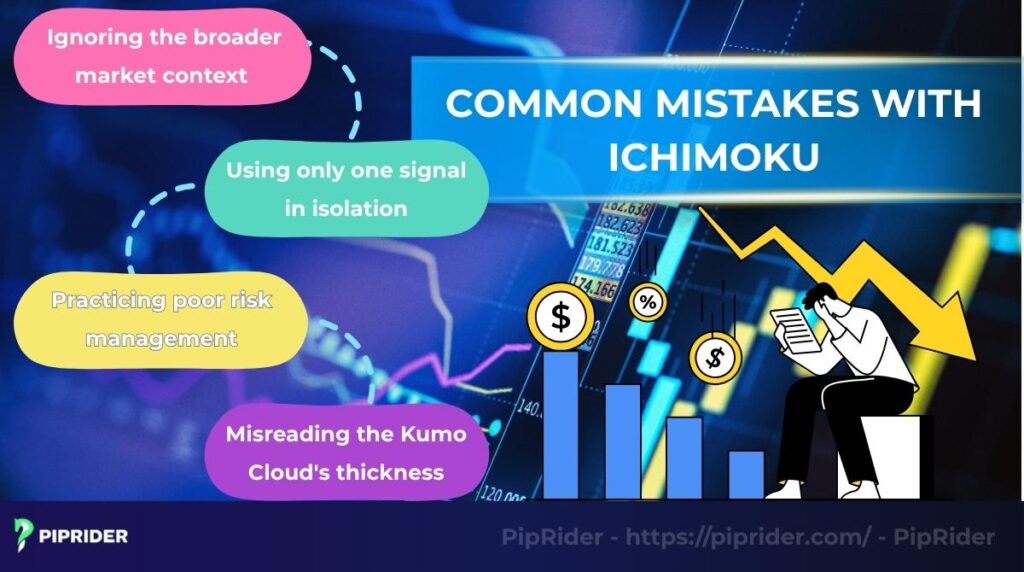
8.1. Mistake 1: Ignoring the broader market context
A trader spots an upward-trending TK cross on an H1 chart and immediately initiates a long position, completely disregarding that the price is heading directly into the resistance levels of a thick, bearish Kumo Cloud on the Daily chart.
- How to avoid: Always begin the analysis on a higher timeframe (e.g., the Daily). The state of the Kumo on this higher timeframe establishes overall strategic bias. Only seek signals on lower timeframes that are in alignment with this larger bias.
8.2. Mistake 2: Using only one signal in isolation
A trader becomes fixated on a single event, like a price exiting the cloud, and enters a trade without seeking any further confirmation.
- How to avoid: Treat Ichimoku as a system that requires consensus. Traders need a majority agreement. A price exiting the cloud is a good starting point, but it transforms into a high-probability trade only when the TK cross and the Lagging Span also align. Always refer back to the checklist.
8.3. Mistake 3: Practicing poor risk management
A trader correctly identifies a strong buy signal but sets their stop-loss just a few pips below the Base Line. The market’s natural ebbs and flows cause a minor dip to test the Kijun, stopping them out just before the main move begins.
- How to avoid: Utilize the system’s own levels for protection. A more robust stop-loss for a long trade could be placed within the Kumo itself or, more conservatively, on the opposite side of the cloud. This provides the trade with adequate room to breathe.
8.4. Mistake 4: Misreading the Ichimoku Cloud’s thickness
A trader observes price approaching a very thin, wispy Ichimoku Cloud and incorrectly assumes it will provide strong support, only to watch price cut through it with ease.
- How to avoid: Understand the meaning behind the cloud’s thickness. A thick cloud is the product of significant, volatile price action in the past, creating a strong area of market “memory” and equilibrium. A thin cloud represents a period of quiet combination and is a much less formidable barrier.
9. Pro tips for using the Ichimoku Cloud in Forex
The Ichimoku Cloud is a comprehensive indicator, but it’s most powerful when used correctly. To help traders get the most out of this versatile tool, here are a few expert tips.
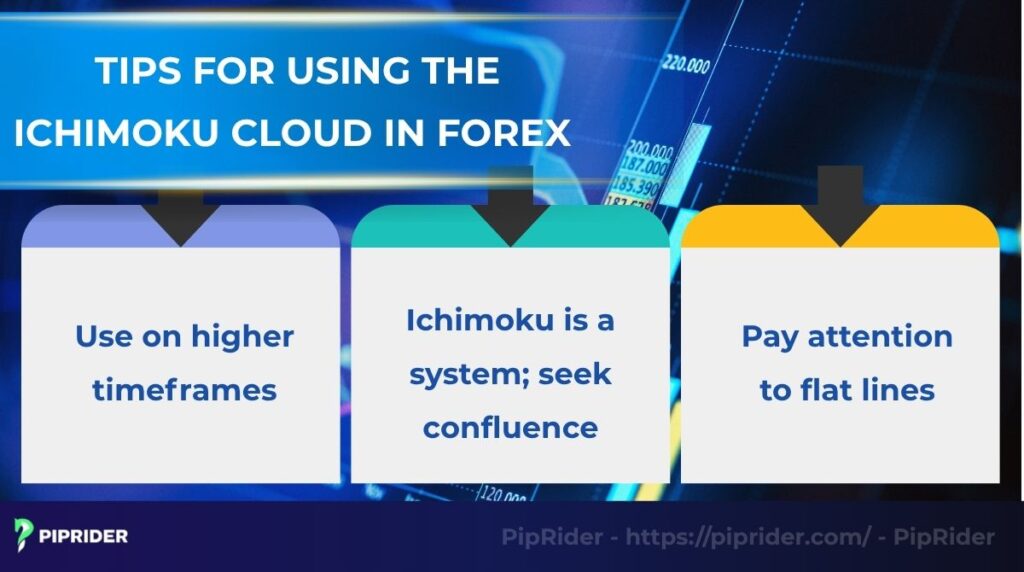
- Usage on higher timeframes: Ichimoku was conceived for long-term trend analysis. Its signals are significantly more reliable and meaningful on the H4, Daily, and Weekly charts. It is generally not suitable for low-timeframe scalping.
- The systemic nature and confluence of signals: The most robust signals in trading come from confluence. Don’t act on an isolated signal. Wait for the checklist to be mostly satisfied. When price, the Kumo, the TK cross, and the Lagging Span all convey the same narrative, traders have a high-probability setup.
- The importance of flat lines: A flat Kijun-sen or a flat top/bottom of the Senkou Span B acts as a potent price magnet, signaling a period of market balance. Price will often gravitate toward and test these flat lines repeatedly.
10. FAQs about the Ichimoku Cloud indicator
11. Conclusion
The Ichimoku Kinko Hyo stands out as a uniquely potent and visual analysis tool that, once mastered, can bring exceptional clarity to your trading strategies. By offering a complete perspective on trend, strength, and support/resistance levels, it empowers you to make more informed choices.
With the Ichimoku Cloud indicator in Forex explained through this guide, you now have a comprehensive roadmap to harness the full capabilities of this system and improve your trading performance.
If you’re still unsure about trading indicators, follow Piprider to read more interesting articles in our Best Technical Indicators category.


